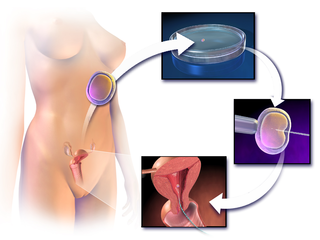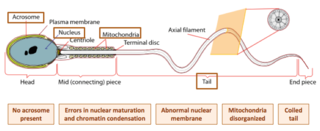
In vitro fertilisation (IVF) is a process of fertilisation where an egg is combined with sperm in vitro. The process involves monitoring and stimulating a woman's ovulatory process, removing an ovum or ova from their ovaries and letting sperm fertilise them in a culture medium in a laboratory. After the fertilised egg (zygote) undergoes embryo culture for 2–6 days, it is implanted in a uterus, with the intention of establishing a successful pregnancy.

Intracytoplasmic sperm injection is an in vitro fertilization (IVF) procedure in which a single sperm cell is injected directly into the cytoplasm of an egg. This technique is used in order to prepare the gametes for the obtention of embryos that may be transferred to a maternal uterus. With this method, the acrosome reaction is skipped.

Assisted reproductive technology (ART) includes medical procedures used primarily to address infertility. This subject involves procedures such as in vitro fertilization (IVF), intracytoplasmic sperm injection (ICSI), cryopreservation of gametes or embryos, and/or the use of fertility medication. When used to address infertility, ART may also be referred to as fertility treatment. ART mainly belongs to the field of reproductive endocrinology and infertility. Some forms of ART may be used with regard to fertile couples for genetic purpose. ART may also be used in surrogacy arrangements, although not all surrogacy arrangements involve ART.

Ryuzo Yanagimachi is a Japan-born American-based scientist. He has made numerous key contributions to the study of mammalian fertilization. He is a pioneer of assisted fertilization technologies such as in vitro fertilization and direct sperm injection into egg which are widely used today in human infertility clinics throughout the world. He was also a pioneer in the cloning field. In 1997 his laboratory at the University of Hawaii at Manoa successfully cloned mice using the Honolulu technique. The first one was a female named Cumulina from the cells that surround the developing ovarian follicle in mice.
Azoospermia factor (AZF) is one of several proteins or their genes, which are coded from the AZF region on the human male Y chromosome. Deletions in this region are associated with inability to produce sperm. Subregions within the AZF region are AZFa, AZFb and AZFc. AZF microdeletions are one of the major causes of male infertility for azoospermia and severe oligozoospermia males. AZF is the term used by the HUGO Gene Nomenclature Committee.

Human oocyte cryopreservation is a procedure to preserve a woman's eggs (oocytes). This technique has been used to enable women to postpone pregnancy to a later date – whether for medical reasons or for social reasons. Several studies have proven that most infertility problems are due to germ cell deterioration related to aging. The uterus remains completely functional in most elderly women, which implies that the factor which needs to be preserved is the woman's eggs. The eggs are extracted, frozen and stored. The intention of the procedure is that the woman may choose to have the eggs thawed, fertilized, and transferred to the uterus as embryos to facilitate a pregnancy in the future. The procedure's success rate varies depending on the age of the woman, and ranges from 14.8 percent to 31.5 percent.
The Genetics & IVF Institute (GIVF) is an international provider of infertility and genetics services and products, and also engages in biomedical research in these fields. The Institute was founded in 1984 by Dr. Joseph D. Schulman and associates. GIVF headquarters are in Fairfax, VA, US, and its facilities include locations in Pennsylvania, Minnesota, California, and Texas in the United States, as well as in China, Mexico, and several other countries.
Teratospermia or teratozoospermia is a condition characterized by the presence of sperm with abnormal morphology that affects fertility in males.

Paul Devroey is a prominent Belgian researcher and professor specialized in human fertility. He worked more than 30 years in the university hospital of the Vrije Universiteit Brussel, where he directed the Center for Reproductive Medicine. Together with André Van Steirteghem and other colleagues from the Center he developed the Intracytoplasmic Sperm Injection (ICSI) technique, in which a single sperm is injected into an egg-cell. This technique is particularly useful in cases where infertility is caused by poor sperm production, thus solving most problems of male infertility. His center also pioneered various other techniques that increase the chances of successful in vitro fertilization, such as preimplantation genetic diagnosis.
FNA Mapping is an application of fine-needle aspiration (FNA) to the testis for the diagnosis of male infertility. FNA cytology has been used to examine pathological human tissue from various organs for over 100 years. As an alternative to open testicular biopsy for the last 40 years, FNA Mapping has helped to characterize states of human male infertility due to defective spermatogenesis. Although recognized as a reliable, and informative technique, testis FNA has not been widely used in U.S. to evaluate male infertility. Recently however, testicular FNA has gained popularity as both a diagnostic and therapeutic tool for the management of clinical male infertility for several reasons:
- The testis is an ideal organ for evaluation by FNA because of its uniform cellularity and easy accessibility.
- The trend toward minimally invasive procedures and cost-containment views FNA favorably compared to surgical testis biopsy.
- The realization that the specific histologic abnormality observed on testis biopsy has no definite correlation to either the etiology of infertility or to the ability to find sperm for assisted reproduction.
- Assisted reproduction has undergone dramatic advances such that testis sperm are routinely used for biological pregnancies, thus fueling the development of novel FNA techniques to both locate and procure sperm.

Dr. Paul J Turek is an American physician and surgeon, men's reproductive health specialist, and businessman. Turek is a recent recipient of a National Institutes of Health (NIH) grant for research designed to help infertile men become fathers using stem cells.
Laura Charlotte Hewitson is a British-born primate researcher noted for her work in the fields of reproductive biology and behavior. She is an affiliate scientist at the Washington National Primate Research Center (WaNPRC) and adjunct associate professor of psychiatry at the University of Texas Southwestern Medical Center. Additionally, she is Research Director of The Johnson Center for Child Health and Development in Austin, Texas. Hewitson was a staff scientist at Oregon Health Sciences University from 1997 to 2001. From 2002 to 2010 she was an associate professor of obstetrics, gynecology and reproductive sciences at the University of Pittsburgh School of Medicine and member of Magee-Women's Research Institute and Foundation (MWRI&F) in Pittsburgh, Pennsylvania.
Jacques Cohen is a Dutch embryologist based in New York, U.S. He is currently Director at Reprogenetics LLC, Laboratory Director at ART Institute of Washington at Walter Reed National Military Medical Center, and Scientific Director of R & D at IVF-online.
Abraham Albert "Al" Yuzpe is a Canadian obstetrician-gynecologist known for his work on human fertility and emergency contraception. The Yuzpe regimen, named after him, is a method of reducing potential unwanted pregnancies, including pregnancy from rape. He published the first studies demonstrating the method's safety and efficacy in 1974.
The history of in vitro fertilisation (IVF) goes back more than half a century. In 1959 the first birth in a nonhuman mammal resulting from IVF occurred, and in 1978 the world's first baby conceived by IVF was born. As medicine advanced, IVF was transformed from natural research to a stimulated clinical treatment. There have been many refinements in the IVF process, and today millions of births have occurred with the help of IVF all over the world.

Globozoospermia is a rare and severe form of monomorphic teratozoospermia. This means that the spermatozoa show the same abnormality, and over 85% of spermatozoa in sperm have this abnormality. Globozoospermia is responsible for less than 0.1% of male infertility. It is characterised by round-headed spermatozoa without acrosomes, an abnormal nuclear membrane and midpiece defects. Affected males therefore suffer from either reduced fertility or infertility. Studies suggest that globozoospermia can be either total or partial however it is unclear whether these two forms are variations on the same syndrome, or actually different syndromes.
Antisperm antibodies (ASA) are antibodies produced against sperm antigens.
The intracytoplasmic morphologically selected sperm injection (IMSI) is a laboratory technique used for In Vitro Fertilisation treatments. High quality sperms are injected into the egg for fertilization, it is an advanced version of ICSI. A high powered microscope is used to pick out and the best sperm cells which are then used in a traditional ICSI protocol. In ICSI a magnification of x400 is used, while in IMSI an amplification of 6000 to 10,000 is used, at least 15 times greater. This allows the sperm to be examined in greater detail, including the nucleus which contains the sperm's genetic material. Use of this method has resulted in higher pregnancy and delivery rates and lower abortion rates. IMSI is a good choice for anyone who has failed IVF cycles in the past, and for couples who have a component of male infertility.
Ernestine Gwet-Bell is a gynaecologist from Cameroon, who supervised the first successful in vitro fertilisation (IVF) treatment in Cameroon.
Dmitri Dozortsev is a Russian-American physician scientist, inventor and researcher. Dozortsev's contributions in research and publications are mostly in the areas of human reproductive medicine and biology. In particular, he is best known for his studies of in vitro fertilisation and embryo transfer. Dozortsev currently serves as President of the American College of Embryology and as Director of Omni-Med laboratories.






